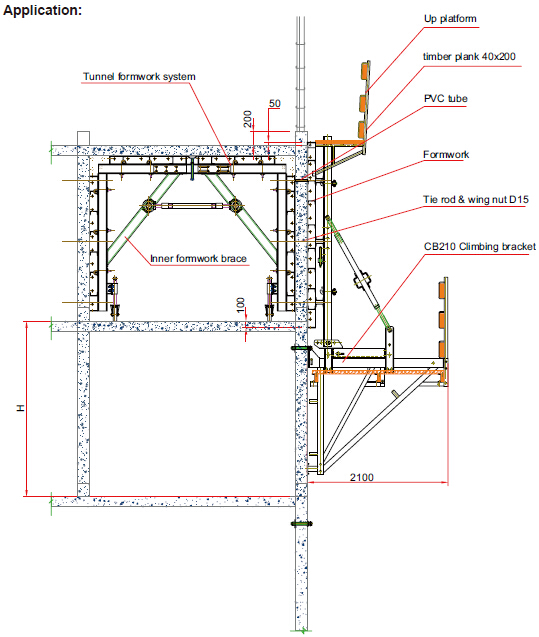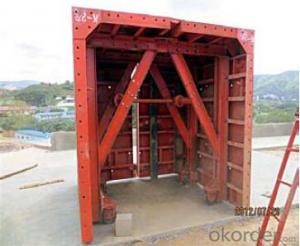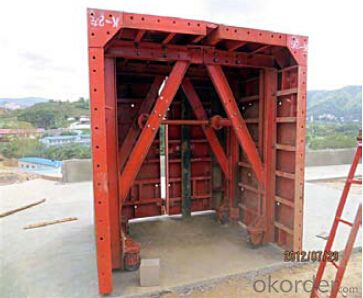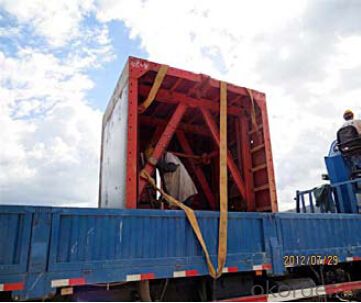Steel Tunnel for Formwork and Scaffolding Systems
- Loading Port:
- Tianjin
- Payment Terms:
- TT OR LC
- Min Order Qty:
- 50 m²
- Supply Capability:
- 1000 m²/month
OKorder Service Pledge
Quality Product, Order Online Tracking, Timely Delivery
OKorder Financial Service
Credit Rating, Credit Services, Credit Purchasing
You Might Also Like
Building Tunnel Formwork:
A compositional steel formwork system mainly used in the building which has regular structure
without beams, the excellent formwork system can make the integral pouring for the wall & slab
easily achieved.
Characteristics:
◆ High stiffness, make perfect shape for concrete.
◆ Easy operation, save labor and force.
◆ Fast forming, repeatedly turnover.

- Q: What are the different types of steel formwork joints and connections?
- There are several types of steel formwork joints and connections commonly used in construction. These include butt joints, lap joints, T-joints, and corner joints. Butt joints are simple connections where two formwork elements are joined end to end. Lap joints involve overlapping two formwork elements and securing them together. T-joints are formed when one formwork element intersects with another at a right angle, creating a T shape. Corner joints are used when two formwork elements meet at a corner, and they are typically secured using brackets or connectors. These various types of joints and connections allow for flexibility and stability in steel formwork systems.
- Q: Can steel formwork be used for both reinforced and unreinforced concrete structures?
- Yes, steel formwork can be used for both reinforced and unreinforced concrete structures. Steel formwork provides excellent strength and durability, making it suitable for supporting the weight and pressure of both reinforced and unreinforced concrete during the casting and curing process.
- Q: Can steel formwork be used for architectural construction projects?
- Yes, steel formwork can be used for architectural construction projects. Steel formwork is a versatile and durable construction material that is commonly used in architectural projects. It offers numerous advantages such as high strength, stability, and reusability. Steel formwork is capable of withstanding high pressure and can provide a smooth and precise finish to concrete structures. Additionally, it is resistant to warping, bending, and shrinking, ensuring the structural integrity of the construction. Steel formwork can be customized to fit any shape or size, allowing architects to create unique and complex designs. Due to its strength and durability, steel formwork can be used repeatedly, making it a cost-effective option for construction projects. Overall, steel formwork is a reliable and efficient choice for architectural construction projects.
- Q: How does steel formwork affect the overall project budget and cost control?
- Steel formwork can have a significant impact on the overall project budget and cost control. While it tends to have a higher initial cost compared to other formwork systems, its durability and reusability can help offset this expense in the long run. Steel formwork also allows for faster construction and requires fewer labor hours, leading to potential cost savings in terms of reduced labor costs. Additionally, its accuracy and precision help minimize material wastage, further contributing to cost control.
- Q: How does steel formwork handle different concrete reinforcement types?
- Steel formwork is a versatile and durable option for handling different types of concrete reinforcement. It is commonly used in construction projects to create temporary molds or structures to hold concrete in place during the pouring and curing process. One of the advantages of steel formwork is its ability to handle different concrete reinforcement types. Whether it is traditional reinforcement such as steel bars or modern reinforcement techniques like fiber-reinforced polymers (FRP), steel formwork can accommodate them all. Steel formwork is designed to be strong and rigid, which allows it to support the weight and pressure exerted by different types of reinforcement materials. Whether it is the weight of steel bars or the tensile strength of FRP, steel formwork can withstand these forces without deforming or collapsing. Additionally, steel formwork is highly adaptable and can be easily adjusted or modified to accommodate different reinforcement types. It can be cut or welded to create openings or recesses for steel bars or other reinforcement materials to pass through. This flexibility ensures that steel formwork can be customized to suit the specific needs of each construction project. Furthermore, steel formwork offers a smooth and even surface finish, which is crucial for ensuring proper adhesion between the concrete and the reinforcement materials. This ensures that the reinforcement is securely embedded within the concrete structure, providing the necessary structural integrity and strength. In conclusion, steel formwork is a reliable and effective solution for handling different concrete reinforcement types. Its strength, adaptability, and ability to provide a smooth surface finish make it an ideal choice for construction projects that require diverse reinforcement materials.
- Q: How does steel formwork affect the overall weight of the structure?
- Steel formwork can have a significant impact on the overall weight of a structure. Compared to traditional timber formwork, steel formwork is generally heavier due to the inherent properties of steel. Steel is denser and heavier than wood, which means that steel formwork will contribute more to the overall weight of the structure. However, the weight of the steel formwork can also be advantageous in certain situations. The increased weight of steel formwork can provide stability and rigidity to the structure during the construction process, ensuring that the concrete is properly supported and shaped. This can lead to a more precise and durable final structure. Moreover, steel formwork is typically more durable and can be reused multiple times, whereas timber formwork often needs to be replaced after a few uses. This can result in a reduced environmental impact and cost savings in the long run, even though steel formwork may initially add more weight to the structure. Ultimately, the effect of steel formwork on the overall weight of a structure depends on various factors such as the size and complexity of the project, the specific design requirements, and the construction method chosen. However, it is important to consider the trade-offs between the weight of the formwork and its benefits in terms of stability, durability, and cost-effectiveness.
- Q: What are the considerations when selecting the appropriate formwork system for a project?
- When selecting the appropriate formwork system for a project, there are several considerations that need to be taken into account. These considerations include the type of structure being constructed, the required finish of the concrete, the project timeline, the budget, and the available resources. The type of structure being constructed is a crucial factor in selecting the formwork system. Different structures, such as walls, columns, or slabs, require different types of formwork systems to ensure proper support and stability. It is important to understand the specific requirements of the structure before choosing a formwork system. The required finish of the concrete also plays a role in selecting the appropriate formwork system. If a smooth and seamless finish is desired, a formwork system that can provide the necessary level of detail and precision must be chosen. On the other hand, if a rough finish is acceptable, a simpler and less expensive formwork system may be sufficient. The project timeline is another key consideration. Some formwork systems are quicker and easier to assemble and dismantle, which can help speed up the construction process. Additionally, the availability of the formwork system and the lead time required for procurement should also be considered to ensure that it aligns with the project schedule. Budget is always an important consideration in any construction project. Formwork systems vary in cost, and it is essential to select a system that fits within the project's budget. It is also important to consider the long-term cost implications, such as maintenance and reusability, to determine the overall cost-effectiveness of the chosen formwork system. Lastly, the available resources, including labor and equipment, should be taken into account when selecting a formwork system. Some systems may require specialized labor or equipment, which may not be readily available or may require additional costs. Considering the resources at hand will help determine the feasibility and practicality of a particular formwork system. In conclusion, selecting the appropriate formwork system for a project requires careful consideration of the type of structure, required concrete finish, project timeline, budget, and available resources. By evaluating these factors, project managers can make informed decisions that will contribute to the successful completion of the project.
- Q: Can steel formwork be used in tunnel construction projects?
- Yes, steel formwork can be used in tunnel construction projects. Steel formwork is a popular choice in tunnel construction due to its durability, strength, and reusability. It provides a robust framework for pouring concrete and helps to achieve precise and accurate dimensions in tunnel construction. Steel formwork can withstand the pressure of the surrounding soil and the weight of the concrete, ensuring the stability and safety of the tunnel structure. Additionally, steel formwork is resistant to corrosion and has a longer lifespan compared to other types of formwork, making it an ideal choice for long-term tunnel construction projects.
- Q: How does steel formwork affect the overall waterproofing of a building?
- The main purpose of steel formwork is to provide stability and shape to wet concrete during the construction process. It does not directly affect the overall waterproofing of a building. Waterproofing is typically achieved through the use of waterproof membranes, sealants, or coatings applied to the external surfaces of the structure. Proper installation and sealing of the formwork joints are important to prevent water leakage during the concrete pouring process. Any gaps or cracks in the formwork can allow water to seep into the structure, potentially compromising the waterproofing system. Additionally, the choice of formwork material indirectly influences the overall waterproofing of a building. Steel formwork, being durable and robust, can withstand the pressure of wet concrete without deforming or leaking. This ensures that the concrete is shaped and compacted correctly, resulting in a more solid and stable structure. A well-constructed concrete framework indirectly contributes to the building's waterproofing capabilities by enhancing its integrity and longevity. In conclusion, while steel formwork does not directly impact the overall waterproofing of a building, it is crucial for maintaining the structural integrity of the concrete during construction. Proper installation and sealing of formwork joints are necessary to prevent water leakage. Ultimately, the choice and correct application of appropriate waterproofing materials determine the building's overall waterproofing performance.
- Q: How does steel formwork handle different concrete testing procedures?
- Steel formwork is highly versatile and can easily handle different concrete testing procedures. Its sturdy and strong structure ensures that it can withstand the pressure and weight of the concrete during testing. Additionally, steel formwork provides a smooth and even surface, which is crucial for accurate testing results. It can also be easily dismantled and reassembled, making it convenient for various testing procedures. Overall, steel formwork is well-suited to handle different concrete testing procedures due to its durability, stability, and adaptability.
Send your message to us
Steel Tunnel for Formwork and Scaffolding Systems
- Loading Port:
- Tianjin
- Payment Terms:
- TT OR LC
- Min Order Qty:
- 50 m²
- Supply Capability:
- 1000 m²/month
OKorder Service Pledge
Quality Product, Order Online Tracking, Timely Delivery
OKorder Financial Service
Credit Rating, Credit Services, Credit Purchasing
Similar products
Hot products
Hot Searches
Related keywords



















